Introduction
Within the intricate realm of industrial machinery, the industrial slip ring exists as an unsung hero, carrying out a vital role almost invisibly. This electromechanical device enables electrical connectivity between stationary and rotating parts in large-scale industrial machinery, ensuring that they function smoothly. Despite the significant role they play in various industrial applications, these devices often fly under the radar, attracting less attention than many more obvious components.
Understood as a specialized type of electrical connector, the industrial slip ring offers a solution to the inevitable wear and tear of traditional wiring systems. By allowing for uninterrupted electrical connectivity during rotation, these devices have proven to be a game-changer within the industrial sector. In contrast to more conventional connector options, the industrial slip ring provides a unique, unrestricted 360-degree functionality.
In the following article, we will delve into the details of this profound industrial component, shedding light on what exactly an industrial slip ring is, how it works, what its normal technical specifications are, and its varied applications. We will also discuss performance requirements, understanding distinct types, crucial considerations while choosing one, maintenance, and some common causes of slip ring failure. A short Frequently Asked Questions (FAQ) section wraps up the article, answering a few common queries about this essential device.
What Is an Industrial Slip Ring?
An industrial slip ring, also known as a rotary electrical joint, is an electromechanical device specifically designed to enable the transmission of electrical signals and power between stationary and rotating parts in a wide array of large-scale industrial machinery and equipment. Its primary function is to ensure that electrical power, data signals, and other operational elements can be smoothly and continuously transferred across a rotating interface, thus overcoming the limitations imposed by traditional wiring connections.
Industrial slip rings consist of conductive brushes and rings that are in constant contact despite the relative rotation between the two. The brushes, connected to the static part of the machine, maintain contact with the rotating rings, which are connected to the rotating component. This configuration allows for the conduction of signals and electric power between the stationary and rotating parts without hindering any motion.
The merit of the slip ring lies in its ability to minimize friction, reduce wear and tear, and greatly enhance reliability, even as it prevents twisting and snagging of cables and wires, which would otherwise result from continuous rotation. Slip rings are used in various fields, with their performance and specifications tailored to application-specific requirements. For example, they can accommodate a wide range of currents, voltages, and operating speeds and be designed to function seamlessly in diverse environments.
Industrial Slip Ring Typical Application
Industrial slip rings play an integral role in numerous applications across multiple industries. They are designed to facilitate the conduction of electrical power and data signals between stationary and rotating components, making them indispensable for the operation of various types of machinery and equipment. Here are some typical applications where industrial slip rings play a vital role:
Wind Turbines

In wind energy systems, slip rings enable the transmission of power and control signals from the stationary nacelle to the rotating hub and wind turbine blades, allowing for real-time adjustments and monitoring of the turbine’s performance and efficiency.
Radar Systems
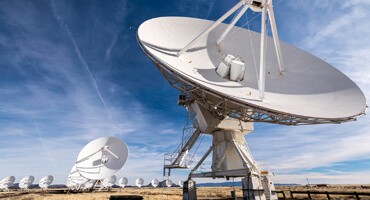
Advanced radar systems often have large rotating antennas that are responsible for detecting and tracking signals. Slip rings in these systems serve to supply electrical power to the antenna while transmitting data from the rotating antenna to the stationary radar control unit.
Heavy Equipment
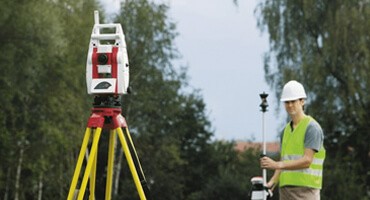
Industrial slip rings are used extensively in heavy-duty excavators, cranes, and material handling systems, ensuring continuous power supply and control signal transmission between the rotating cab or arm and the stationary chassis or base.
Centrifuges
In many process industries, centrifuges are used for separating different components of a liquid mixture. Industrial slip rings facilitate the transfer of real-time data about operational parameters, such as temperature and pressure, between the rotating centrifuge drum and the stationary control system.
Automated Production Lines

In manufacturing plants with automated production lines, slip rings are critical for delivering power, data signals, and pneumatic or hydraulic energy to rotating components, such as robotic arms or turntables.
Aerospace Equipment
Slip rings are extensively used in aerospace systems for applications like power and signal transmission in rotary joints, satellite antennas, and surveillance equipment.
Medical Imaging

Medical devices such as CT (Computed Tomography) and MRI (Magnetic Resonance Imaging) machines heavily rely on slip rings to maintain a smooth flow of electrical signals and power between the rotating gantry and the stationary control and data acquisition system.
Video Surveillance Systems

Slip rings are frequently used in pan-tilt cameras or continuous rotation cameras for security and surveillance applications. They ensure a steady transmission of power and data signals between the stationary control unit and the moving camera for real-time control and monitoring.
These examples represent just a fraction of the applications where industrial slip rings are employed, showcasing their versatility and importance in diverse industries and scenarios.
Industrial Slip Ring Technical Specifications
Industrial slip rings, depending upon the machine or application they serve, come with a broad spectrum of technical specifications. Understanding these specifications is key when opting for a slip ring for specific industrial needs. Here are six crucial technical specifications of industrial slip rings:
Current Rating
This is one of the primary specifications and denotes the maximum current that a slip ring can safely transmit without damage or overheating. The rating can range from milliamperes (mA) in the casing of small, delicate systems to high-current applications consuming tens to hundreds of Amperes (A). The current rating is determined based on both the power needs of the device it serves and the design of the slip ring itself.
Voltage Rating
The voltage rating signifies the highest voltage level that the slip ring can handle safely. This could span from a few volts for miniature devices to thousands of volts for heavy-duty industrial machinery. The material of the slip ring and the insulation between the conducting parts play significant roles in determining this voltage rating.
Operating Speed
Referring to the maximum rotation speed that the slip ring can handle, the operating speed is critical for high-speed applications. It’s determined by the design and material of the brushes and rings, with specific designs catering to applications that demand high rotational speeds.
Number of Circuits
The number of circuits in a slip ring essentially tells you how many separate electrical signals, power channels or paths can be simultaneously transmitted through the slip ring. This count can vary widely, from just one or two, up to hundreds in complex, multifunctional systems.
Housing Material
The material housing the slip ring must be robust enough to protect the internal components from physical damage, environmental hazards, and harsh operating conditions. Housing materials can range from plastics for lightweight applications, to metals such as aluminum or stainless steel for heavy-duty or high-temperature applications.
Contact Material
The material of the contact – the surface where the brushes touch the rings – is crucial in determining the electrical conductivity, wear rate, and overall lifespan of the slip ring. Often, contact materials are carefully chosen based on their electrical and mechanical properties. Popular choices include precious metals like gold or silver and alloys because they are both good conductors of electricity and demonstrate resistance to corrosion.
These technical specifications are integral to the performance of an industrial slip ring and should be carefully investigated according to the needs and conditions of the specific application or use.
Performance Requirements for Industrial Slip Ring
Every industrial application imposes unique demands on its slip rings. However, there are some universal performance requirements that industrial slip rings should meet in order to ensure smooth operation and longevity. Here are five core performance parameters:
Reliability
Given that slip rings play such an integral role in various industrial applications, their reliability is of paramount importance. This includes long-lasting, dependable performance under various operating conditions, minimum downtime for repairs or replacements, and a low failure rate.
Life Expectancy
The life expectancy of industrial slip rings often depends on their operating conditions, including speed, temperature, and load. High-quality slip rings should be designed to withstand thousands or even millions of rotations over their operational lifespan.
Signal Integrity
In applications involving data or signal transmission, the slip ring must ensure a distortion-free and stable relay of signals. This involves no interruption, no abnormal noise, and no attenuation of the signal during transmission.
Low Friction
Low friction is a pivotal requirement since high friction would wear away the conductive material of the rings and brushes, leading to a shorter lifespan and higher maintenance costs. Proper design, choice of material, and lubrication are associated with reduced friction.
Environment Tolerance
Depending on the application, slip rings might be exposed to a variety of environmental conditions, such as extreme temperatures, high humidity, dust, corrosive materials, or vibration. They should be designed to resist these environmental factors without compromising their performance.
Maintenance Requirement
Although regular maintenance can extend the lifespan of slip rings, it’s important that the device design limits the frequency and complexity of maintenance tasks. Some advanced slip rings come with self-lubricating brushes or construction materials that minimize maintenance needs.
Ensuring these performance requirements can greatly improve the operational lifespan, effectiveness, and efficiency of industrial slip rings, whilst reducing downtime and maintenance demands. These requirements should be tailored to the specific application of the slip ring.
Types of Industrial Slip Rings
Based on their design, materials, and intended applications, industrial slip rings can be broadly categorized into several types:
Capsule Slip Rings
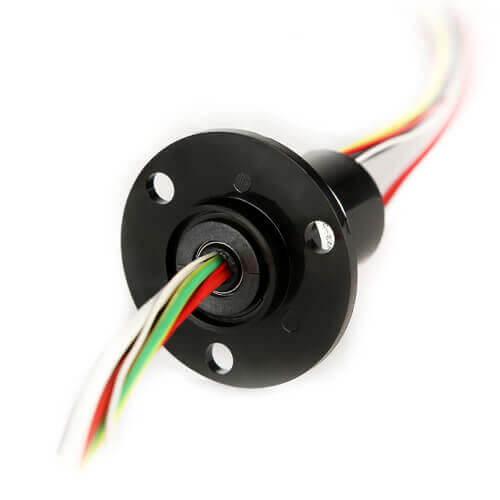
Also known as miniature or compact slip rings, these are designed for applications that demand a compact size and lightweight, typically in video systems, testing equipment, or small wind turbines. Despite their miniature size, they can accommodate multiple circuits ranging from power signals to high-frequency signals.
Through-Bore Slip Rings
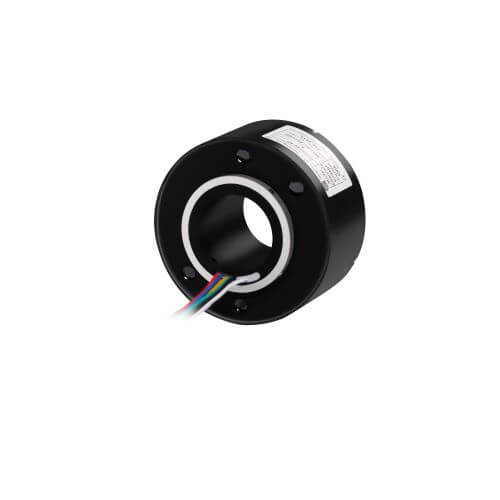
These slip rings feature a central hole that allows for routing hydraulic or pneumatic lines, or a drive shaft. They’re ideal for tasks that require 360-degree continuous rotation while transferring power and data, like in large wind turbines or radar antennas.
Pancake Slip Rings

Characterized by their flat and disc-like configuration, pancake slip rings are chosen for their height-sensitive situations where length is not restricted. They are beneficial where installation space is limited in the height direction.
Ethernet Slip Rings
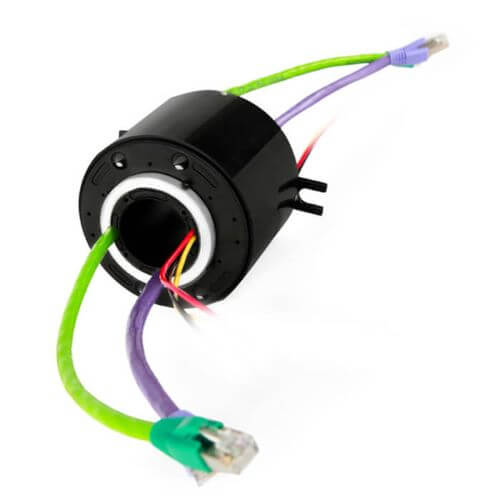
These slip rings are designed specifically for Ethernet transmission between stationary and rotating parts. They are mostly used in high-speed data transmission applications, including video systems, high-speed trains, or automated machinery.
Wind Turbine Slip Rings
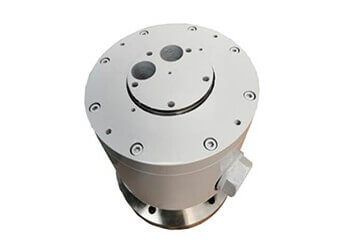
Specifically designed for wind turbines, these slip rings can transfer power and control signals, allowing the blades to rotate freely and efficiently. They can operate in extreme weather conditions and handle high rotational speeds.
Fiber Optic Rotary Joints (FORJ)
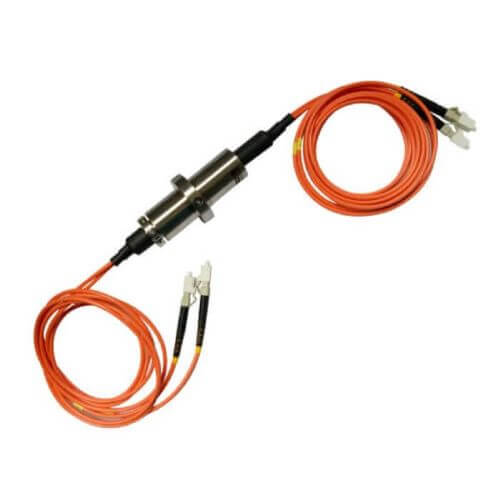
Though technically not a slip ring, FORJs serve a similar purpose in the transmission of optical signals between stationary and rotating parts. They are used in applications that demand high-speed data transmission and high bandwidth.
Mercury Wetted Slip Rings
These slip rings utilize liquid mercury as the conducting element instead of traditional brush contacts. They often offer low resistance, high conductivity, and extended lifespan but are limited to applications where mercury leakage can be safely managed.
Remember that the choice among these types depends on specific application needs, including engineering restrictions, environmental conditions, and performance requirements.
How to Choose an Industrial Slip Ring?
Choosing the correct industrial slip ring is crucial for optimal machine performance, reduced maintenance needs, and overall productivity of your system. Here are several factors to consider when choosing an industrial slip ring:
Determine Your Specific Requirements
Understand your device/application configurations, including the necessity of data and power transmission, the number of circuits needed, expected rotation speed, torque requirements, and available installation space.
Technical Specifications
Evaluate the electrical requirements such as maximum current and voltage ratings, and operational parameters like maximum operating speed, necessary insulation level, and operating temperature range.
Environment
Take into account the operating environment, including temperature extremes, exposure to moisture or dust, harsh chemicals, and mechanical vibrations or shocks. Choose slip rings designed to stand up to these conditions.
Performance Expectations
Consider your performance expectations, including long-term reliability, life expectancy, maintenance needs, and acceptable signal noise. These will help guide your choice.
Type of Slip Ring
Based on the above points, choose the type like capsule, through-bore, pancake, Ethernet, Mercury wetted, FORJ, or any specific type that best suits your application.
Availability of Spare Parts and Service
Consider the manufacturer’s after-sale service and the availability of spare parts if required. Also, the presence of a knowledgeable technical support team is crucial to tackle any unexpected operational issues.
Cost
Evaluate the cost not only based on the initial purchase price but also on installation expenses, operational costs, and anticipated maintenance and replacement costs over the life of the slip ring.
Remember, when deciding on an industrial slip ring, all these factors should be considered holistically, ensuring you end up with a solution that meets all your operational requirements optimally.
Industrial Slip Ring Maintenance and Cleaning
Proper maintenance and cleaning of slip rings can significantly extend their operational life and overall performance. Let’s delve into some crucial steps for industrial slip ring maintenance and cleaning:
General Maintenance
Regular Inspection: Frequently inspect the slip ring assembly for wear and tear. Check for signs of overheating, build-up of debris, or tarnishing of contacts.
Avoid Overloading: Ensure the slip ring is never subject to power or voltage higher than its rated capacity as it may lead to overheating and accelerated damage.
Lubrication: Lubrication reduces friction and wear between brushes and rings, extending their lifespan. Use only the manufacturer-recommended lubricants and follow their guidelines for lubrication intervals.
Cleaning Procedure
Cleaning the slip ring involves the removal of dirt and grime from the ring and brush surfaces. Here’s a general procedure:
Disconnection: Firstly, disconnect the power source to ensure a safe cleaning environment.
Cleaning Solution: Use a non-abrasive and non-corrosive cleaning agent. Alcohol or a mild soap solution often works well for slip ring surfaces.
Cleaning Process: Using a soft, lint-free cloth dampened in the cleaning solution, gently clean the ring and brush surfaces.
Drying: Allow the components to air-dry, or use a soft dry cloth to pat them dry.
Reconnection: Once all the components are thoroughly cleaned and dry, reconnect the slip ring assembly.
Post-Cleaning Checks
After the cleaning process, carry out these checks:
Visual Check: Ensure there’s no residual dirt and no visible damage on the rings or brushes.
Resistance Check: Use a multimeter to check the resistance across the brushes and rings. Any abnormal increase could indicate a problem.
Regular maintenance and cleaning can significantly improve the performance of a slip ring and reduce the potential for unplanned downtime. Always follow the manufacturer’s guidelines for specific maintenance and cleaning procedures to ensure you maintain the warranty and maximum potential of your slip ring.
Causes of Industrial Slip Ring Failure
Industrial slip ring failures can be attributed to a variety of factors. Identifying these factors is crucial in effectively troubleshooting the problems and mitigating future failures. Below are some common causes of industrial slip ring failure:
Excessive Load
Overloading slip rings beyond their rated voltage or current can cause burnout, deformation, or melting of ring tracks and brushes.
Environmental Factors
Slip rings exposed to harsh environmental conditions like extreme temperatures, high humidity levels, corrosive chemicals, dust, and grit, or severe vibrations can experience accelerated wear and subsequent failure.
Incorrect Installation
Slip rings require careful installation conforming to the manufacturer’s guidelines, taking into consideration factors such as alignment and balance. Incorrect installation can result in physical damage, increased friction, and premature failure.
Inadequate Lubrication
Adequate lubrication is crucial for reducing friction between the rings and brushes. Inadequate or incorrect lubrication can lead to increased wear, overheating, and ultimate component failure.
Poor Maintenance: Neglecting periodic maintenance and cleaning can cause an accumulation of dust and debris, causing increased friction, poor electrical conduction, and reduced performance.
Improper Storage
Storing slip rings in unfavorable conditions—too hot, too cold, too humid, or too dry—can lead to damage even before the slip rings are installed.
Mechanical Stress
Any mechanical shock or stress exerted on the slip ring, such as an accidental drop or impact, can cause irreversible physical damage and subsequent failure.
Quality of Components
Low-quality rings and brushes may wear quickly under operational conditions, leading to premature failure.
Understanding these causes can be instrumental in selecting high-quality slip rings, implementing proper installation and maintenance procedures, and thereby augmenting the lifespan and performance of your industrial slip rings.
Conclusion
Industrial slip rings are crucial components in a range of applications, enabling the transmission of data and power between stationary and rotating parts. Given the varied nature of their deployment, there’s a range of types, each designed to cater to specific requirements—be it capsule slip rings in compact spaces, through-bore slip rings for 360-degree continuous rotation, Ethernet for high-speed data transmission, or fiber optic rotary joints for high-bandwidth transmission.
Selecting the right slip ring is important, and requires considering factors like electrical demands, expected performance levels, mechanical configuration, operating environment, after-sale services, and overall costs.
However, even with the most suitable selection, maintaining performance and longevity demands routine care. Regular inspection, avoiding overloading, lubrication, and careful cleaning are some steps that can significantly extend the operational life of slip rings.
It’s also critical to understand the typical causes of failure in industrial slip rings, such as excessive load, environmental factors, incorrect installation, poor maintenance, inadequate lubrication, improper storage, mechanical stress, and low-quality components. Recognizing these factors can inform better practices in the selection, installation, usage, and maintenance of slip rings.
As industries continue to evolve towards automation and high-speed data transfer, ensuring optimal performance from slip rings becomes increasingly essential. A holistic approach—a sound understanding of requirements, careful selection, diligent maintenance, and proactive troubleshooting—will ensure that industrial slip rings continue to perform as the steadfast workhorses they are, enabling myriad applications across industries.
FAQ About Industrial Slip Ring
Q: What is the lifespan of an industrial slip ring?
A: The lifespan of an industrial slip ring largely depends on the operating condition and maintenance. Generally, they can last for many years with proper care and consistent maintenance.
Q: Can I customize an industrial slip ring?
A: Absolutely. Many manufacturers offer customized industrial slip rings to meet specific application requirements.
Q: Why is my slip ring overheating?
A: Overheating in slip rings can be a result of several factors like excess current, incorrect installation, insufficient cooling, or a lack of maintenance.
Q: Are all slip rings the same?
A: No, slip rings are available in various types and specifications, each designed to cater to specific industrial applications. These differences include size, material, the number of circuits, and many other factors.
We hope this comprehensive guide enhances your understanding of industrial slip rings and enriches your appreciation for their purpose and use in enhancing industrial machine efficiency.
See What We Can Do

